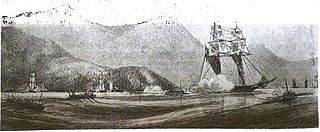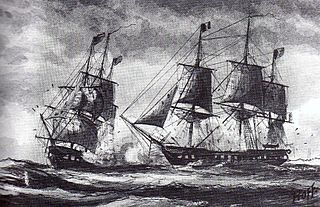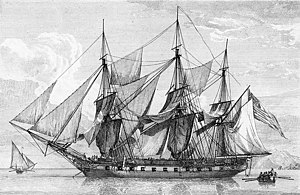USS Baltimore was a ship of the United States Navy.

USS Constellation was a nominally rated 38-gun wooden-hulled, three-masted frigate of the United States Navy.
The first USS Eagle, a schooner, was built at Philadelphia, Pennsylvania, in 1798, and commissioned in the Revenue Cutter Service under the command of Captain H. G. Campbell, USRCS.
USS Ganges was a man-of-war in the United States Navy during the Quasi-War with France.

USS Experiment was a schooner in the United States Navy during the Quasi-War with France.
The first USS Norfolk was a brig in the United States Navy during the Quasi-War with France.

L'Insurgente was a 40-gun Sémillante-class frigate of the French Navy, launched in 1793. During the Quasi War with the United States, the United States Navy frigate USS Constellation, with Captain Thomas Truxtun in command, captured her off the island of Nevis. After her capture she served in the United States Navy as USS Insurgent, patrolling the waters in the West Indies. In September 1800 she was caught up in a severe storm and was presumed lost at sea.

USS Pickering was a brig, the 1st brig built for the UCRC Service, in the United States Revenue Cutter Service and then the United States Navy during the Quasi-War with France. She was named for Timothy Pickering, then the Secretary of State.
The first USS George Washington was a frigate in the United States Navy. She was named after United States Founding Father and President George Washington.
The second USS Delaware was a ship which served in the United States Navy during Quasi-War with France.
The second USS General Greene was a frigate in the United States Navy during the Quasi-War with France.
USS Merrimack, was a ship launched by an Association of Newburyport Shipwrights and presented to the Navy in 1798. She was the first ship of the Navy to be named for the Merrimack River. She saw action in the Quasi-War.
USS Portsmouth was constructed for the United States Navy in 1798 by master shipbuilder James Hackett to a design of Josiah Fox at what is now Badger's Island in Kittery, Maine, directly across the Piscataqua River from Portsmouth, New Hampshire. She was built with funds contributed by the citizens of Portsmouth.
USS Augusta was a brig purchased by the US Navy on 30 June 1799 at Norfolk, Virginia. She mistakenly went to Trenton, New Jersey arriving on 13 September, she was then ordered to Marcus Hook, Pennsylvania for inspection by naval constructor Joshua Humphreys to see if the transport would be suitable for use as a warship. Capt. Bird was replaced by Lieutenant Archibald McElroy on the 13th. Humphreys approved and fitting out began in September. She was placed in commission for service in the Quasi-War with France sometime late in 1799.
USS Richmond was a brig purchased for the US Navy in 1798 by the citizens of Richmond, Petersburg, Manchester and Norfolk, Virginia, while being built at Norfolk as Augusta for a Mr. Myers. Renamed Richmond, she was fitted out in the fall of that year and in December stood out from Hampton Roads for the Caribbean with Captain Samuel Barron in command for service in the Quasi-War with France.
The first USS Patapsco was a sloop in the United States Navy.

HMS Vengeance was originally the 48-gun French Navy frigate Vengeance and lead ship of her class. She engaged USS Constellation during the Quasi-War, in an inconclusive engagement that left both ships heavily damaged. During the French Revolutionary Wars, HMS Seine hunted Vengeance down and captured her after a sharp action. She was recommissioned in the Royal Navy as the 38-gun fifth rate HMS Vengeance, but the British apparently never returned her to seagoing service. Accounts are divided as to her eventual fate. She may have been broken up in 1803 after grounding in 1801, or continued as a prison ship until 1814.

Berceau was a 22-gun corvette of the French Navy, built to a design by Jacques-Noël Sané, and launched in 1794. The Americans captured her in 1800 but restored her to France the next year. She then served in the Indian Ocean before returning to Spain, where she was broken up in 1804.
The Connecticut was a sailing frigate built by Seth Overton at Chatham, Conn. and launched 6 June 1799 at Middletown, Conn. During outfitting, probably on or just before 7 July she foundered. She was refloated. She sailed 15 Oct. 1799 under the command of Captain Moses Tryon for the Guadaloupe Station, arriving off Puerto Rico on 28 October. She cruised in the West Indies for a year during the Quasi-War with France, protecting American commerce from French privateers. Connecticut's successful career was highlighted by the capture of four privateers and the recapture of seven American merchantmen. On 7 November, 1799 she recaptured a schooner captured 15 days earlier. On 6 December she recaptured brig "Penelope" captured by French privateer "Fleur de Mair" on 3 December. On 29 December she captured off Point Petre French privateer brig "Conqueror of Italy", the most successful privateer operating out of Guadeloupe having captured 200 American merchant ships. On 14 January, 1800 She fired upon a privateer but it found shelter by a fort on Demerara, later that day she chased a ship ashore at Deseada which bilged and sank. Arriving at New London, Conn., 18 Oct. 1800. Connecticut was sold at New York in 1801 for $19,300.

Diligente was a French Navy Naïade-class corvette, launched in 1794 as a brig. HMS Crescent captured her in the Antilles in 1800. The British took her into service as a 14-gun transport and sold her in 1814.








